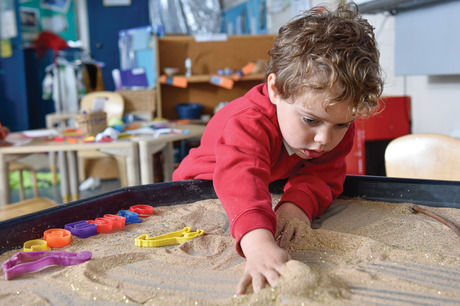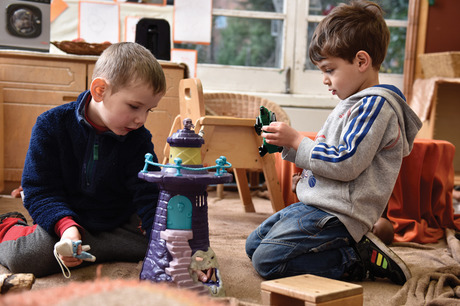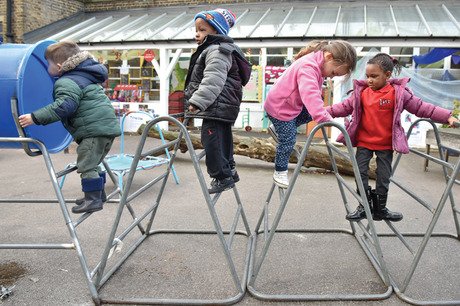their external senses, such as taste and touch, and their internal
senses of movement and body awareness. Anne O'Connor considers how these senses help to build understanding, when problems might arise, and how practitioners can make sure they are offering suitable environments

Although it is a subject that has been much debated we tend to think in terms of five main senses: sight, taste, touch, hearing and smell. These are our external senses that pick up information from the world outside us. However, most specialists in child development would now agree that there are two further internal senses that are hugely important. These are the vestibular and proprioceptive senses, though we can think of them more simply as the sense of movement and the sense of (internal) body awareness.

MULTI-SENSORY LIFE
Rarely do our senses work in isolation. Imagine you are in the park on a summer's day. Unless you have a sensory impairment, your eyes will probably see trees and grass and probably people. Your ears will be hearing the sounds of the birds and children playing. Your nose might be smelling cut grass, the scent of those trees, flowers and other vegetation, maybe even a hotdog seller or a barbecue. If you concentrate you can feel the fresh air against your skin; sit down and you will feel the bench under you or the grass on the ground.
Your vestibular and proprioceptive senses will be on the go as you negotiate your way through the park, walking, running, kicking a ball, even getting up and down off the grass or positioning your body on the bench.
Taste is up to you - I wouldn't recommend you lick the grass, but should you choose to have an ice cream, you can taste it while still experiencing all those other sensory experiences. As Lyndsey Biel and Nancy Peske comment in Raising a Sensory Smart Child, life really is 'a multi-sensory event' (2009:28).
Although some of these sensations will be very close to our consciousness, we can choose to 'foreground' some more than the others. Perhaps you notice the taste of that ice cream, or the sounds of the birds, so that you become less conscious of the other sensory experiences while you are concentrating on just one or two.
The ability to 'foreground' in this way is immensely important, as it enables us to prioritise sensations and the meanings that we select from the bombardment of sensory stimuli present in our environment.
If you choose to hang upside down from a tree or go for a spin on the roundabout, your proprioceptive and vestibular sense will come more to the foreground as your brain and body organise and accommodate the extreme changes of position, though you won't notice it until you start to feel dizzy or light-headed.

MAKING CONNECTIONS
We think of the senses as sending messages to our brain so that we can understand and respond to the world around us. They are 'the filters through which we internalise the world around us and come to know our own bodies' (Connell and McCarthy 2014:51). However, even more importantly, they also provide the activity and that actually develops and build our brains and nerve networks.
Learning is all about making connections. Each time a connection is made, it builds a stronger pathway in the brain, reinforcing that pathway so that the messages are sent much quicker each time.
Perhaps you can't remember the first time you tasted ice cream, but it will certainly have been a novel experience unlike any other. The first sense to be triggered by ice cream will probably be sight and possibly smell - with taste likely to follow on and be the strongest.
After we have had ice cream lots of times, we not only become accustomed to it but our brains are also able to imagine what it feels like to eat ice cream. Those connections become so strong that just the word 'ice cream' will become associated with the taste and tactile experience of a vanilla cornet.
This means we can now anticipate the experience of eating ice cream and ultimately make decisions about whether or not it is an experience we want to repeat - and when and how often we might want to repeat it. So, the senses play an important role in helping us work out how we feel about the sensations we experience. Do we like them or not? Do they irritate or soothe us? Do they make us feel good or bad? Do they hurt or make us feel better?

FILING EXPERIENCES
Recognition and memory play a part in decision-making, storing up sensory experiences, information and knowledge that we can draw on to make decisions and choices. It is as though the brain has filing cabinets filled with material for us to search through and draw on. Of course, ideally, the process needs to be a lot faster than standing at a drawer rifling through a whole lot of files, so we need to have efficient strategies for managing all this information.
In this technological age, perhaps a computer analogy might work better, so try thinking of it as a 'drop-down' list that is triggered automatically when the cursor rolls over or touches a heading. Our brains provide us with a list of experiences that we can make connections with, whenever we meet something new or similar.
As Gill Connell and Cheryl McCarthy describe in A Moving Child is a Learning Child (2014), the child's brain starts 'by associating the new with what he already knows, which enables him to make initial assumptions'. The child has experienced cold, white, creamy stuff before and they know they like it. But what if this ice cream looks different, and is brown? Grown-ups might call it ice cream, but only when it has been tasted will the child be able to make the judgement that they do, indeed, like chocolate ice-cream as much as they like vanilla.
Judgement leads to response - the child either likes it or they don't and as we know with children, 'anything new can spark a highly charged response. Whatever his reaction, he'll be a little wiser for the experience and a little more prepared for the next new thing' (Connell and McCarthy, 2014:53).
Chocolate ice cream will have been added to the child's drop-down list' of ice creams - and as they get older will be added to categories such as 'puddings', 'treats', things you buy in the park, as well as foods that live in the freezer or that you can get from a van.

MOVEMENT AND THE SENSES
Movement has a much bigger part to play in sensory development than we might think. According to Connell and McCarthy, 'Physical experiences (movement) stimulate the senses, which collect information and deliver it to the brain for analysis, interpretation, reaction and storage as memory.'
They liken the senses to 'scouts' who head out to 'bring news of the world to the brain so it can decide what to do next. They act as the fuel that keeps a child's move-to-learn cycle moving' (Connell and McCarthy, 2014:51).
As an example, Connell and McCarthy describe an infant finally reaching out to touch a shiny object that they have been looking at for weeks. This signals that the brain has decided it needs more information and has sent out the hand to touch it, triggering the sense of touch to bring in that information. To continue with our example of the ice cream, that first lick triggers the tongue and the mouth to move, either to reject the sensations or to repeat them. In an older infant, the trigger might be to stick their fingers in the ice cream or to reach out for the cornet or spoon and hold it for themselves, ensuring it doesn't get taken away.
Connell and McCarthy go on to describe how movement and the senses 'share a special and reciprocal relationship in the learning process'. (Connell and McCarthy, 2014:52).
The senses motivate movement. The sight of the shiny object and the taste of the ice cream both stimulate the arms to move. Seeing first and then reaching for something is a frequent experience for all of us - the sense of sight initiates the act of movement which activates more sensory experience.
The senses are stimulated by movement, such as when the baby reached for the shiny object or the ice cream, the sense of proprioception (internal body awareness) is engaged in order to work out what the arm, hand and fingers have to do to touch something. Connections are made and sharpened and the baby receives valuable messages about intentional and deliberate movements as well as the feel of shiny objects and the properties (and joys) of ice cream.

SENSORY PROCESSING AND INTEGRATION
All the information from the senses has to flow swiftly and without interruption to the right parts of the brain to be able to be processed effectively. We have known for a long time that problems with sensory processing are recognised as symptoms of stroke and multiple sclerosis, vertigo and other medical conditions (Biel and Peske, 2009:13). However, more recently there has been acknowledgement of the implications of problems with sensory integration.
Connell and McCarthy describe this as a jigsaw puzzle, with all the different sensory experiences (the pieces) needing to be in place - and integrated - before the child can see the full picture and 'make sense' of what their senses are telling them.
'Until the brain integrates all the pieces, the child may not fully understand the picture. Sensory integration, therefore, greatly affects not only what a child perceives, but also how he interprets, understands and responds to sensory information - in other words, how he learns' (Connell and McCarthy, 2014:53),
Sensory impairment
It is important to explain here that a problem with sensory processing or integration is very different to a sensory impairment. For example, a child with a hearing impairment does not physically hear sound in the typical way. Sounds may be dulled, distorted or completely absent due to a malfunctioning of the mechanisms of the ear and the hearing system.
A child with an audio processing difficulty, however, may have perfect hearing but the difficulty lies with the brain's ability to process, modulate or discriminate sound in ways that make it tolerable and easy for the child to make all the right connections between a whole range of sounds (including words) and their meanings.
Traffic jams in the brain
Building on the pioneering work of Florence Scott in this field, Dr A Jean Ayres developed a model for theory and practice with regards to sensory integration dysfunction. Ayres likened the condition to a 'traffic jam in the brain', preventing sensory information from getting to the right parts of the brain so that the child can act on it. Although the condition is not yet officially recognised as a disorder, this work is being furthered by a wide range of professionals drawing on research and clinical experience in neuropsychology, neurology and child development. They believe that 'different sensory preferences and intolerances affect play, work, learning, social interactions and everyday activities such as dressing and eating and that there are specific techniques and strategies that can improve a person's ability to integrate and use sensory information' (Biel and Peske, 2009:13).
Sensory stimulating environments
Although children need stimulating environments from birth to aid their sensory development, it is important that the stimulation is 'just right' for them as individuals.
Children quickly learn to have preferences and some children seem to prefer the familiar while others seem to be constantly craving new sensations. The first might be easily dismissed as 'fussy' or 'picky' while the second might draw concern for their 'butterfly' mind or inability to settle to an activity. However, as Connell and McCarthy explain, 'striking the right sensory balance, like everything else in early childhood, is a matter of trial and error'.
Getting to know our children really well helps us to know not just what sensory experiences our children prefer, but also what experiences they need more of, and when and how to introduce them so that their sensory development is well balanced and healthy (see below).
Creating a sensory-rich environment
 To ensure that the sensory development of children in your care is well-balanced and healthy:
To ensure that the sensory development of children in your care is well-balanced and healthy:
- Provide a variety of singleand multi-sensory experiences. Some activities like listening games stimulate just one sense, while others, such as a trip to the park, will provide a truly multi-sensory experience. It is important to have a mix of both so all the senses are stimulated in different ways.
- Provide messy activities. These are important for increasing tactile experience. Soapy hand (and body) washing afterwards adds to the sensory experience.
- Introduce new experiences gently, and follow the child's lead. Forcing children to play with gloop before they are ready won't build positive connections. Let them watch and find their own way of engaging with the experience. If children are very resistant, be creative. For example, 'messy' materials are often less threatening when they are warmed up rather than cold.
- Create environments that are visually soothing and stimulating at the same time. We tend to assume that environments for young children should always be visually stimulating, but beware of the temptation to overdo it. Get down low and look at the setting from the child's point of view.
- Remember you, the practitioner, are a prime source of sensory stimulation. Gentle and supportive touch, friendly hugs, soothing strokes and snuggles, stimulating tickles and squeezes are crucial to a child's sensory development. Children watch your face, your body language and the colours of your clothes. They listen to your voice, hear the way it changes when you tell a story or show excitement and they discriminate between the voices, languages and accents of the adults around them.
- Be a sensory role model, trying new things and revelling in new experiences. There is no better way of encouraging children to get involved in an unfamiliar activity than just playing by yourself - they will always want to join in. If you have some sensory resistance to an activity (perhaps you don't like the feel of mud or getting messy, for example), it might be worth exploring where that resistance originated. Give yourself permission to explore the activity slowly, but take a risk and try it. Children will take their lead from you, and it is important that your resistance doesn't influence their feelings in a negative way.
- Remember that movement is fundamental to sensory development. Provide opportunities for children to lead their own movement activity, exploring their physicality, and delighting in their bodies and in the sensations they experience as they interact with the world.
Anne O'Connor is an early years consultant and author, www.primedforlife.co.uk

MORE INFORMATION
- A Moving Child Is A Learning Child by Gill Connell and Cheryl McCarthy (2014), Free Spirit Publishing
- Raising a Sensory Smart Child by Lindsey Biel and Nancy Peske (2009), Penguin
- Sensory Integration and the Child by A Jean Ayres (2005), WPS
- Sensory Intergration Network, www.sensoryintegration.org.uk
- The Out-of-Sync Child by Carol Stock Kranowitz (2005), Penguin
- Too Loud, Too Bright, Too Fast, Too Tight by Sharon Heller (2004), HarperCollins.









